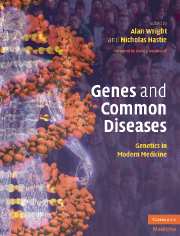Book contents
- Frontmatter
- Contents
- List of Contributors
- Foreword
- Section 1 Introductory Principles
- Section 2 Common Medical Disorders
- 13 Developmental disorders
- 14 Genes, environment and cancer
- 15 The polygenic basis of breast cancer
- 16 TP53: A master gene in normal and tumor suppression
- 17 Genetics of colorectal cancer
- 18 Genetics of autoimmune disease
- 19 Susceptibility to infectious diseases
- 20 Inflammatory bowel diseases
- 21 Genetic anemias
- 22 Genetics of chronic disease: obesity
- 23 Type 2 diabetes mellitus
- 24 Genetics of coronary heart disease
- 25 Genetics of hypertension
- 26 Obstructive pulmonary disease
- 27 Skeletal disorders
- 28 The genetics of common skin diseases
- 29 Molecular genetics of Alzheimer's disease and other adult-onset dementias
- 30 Major psychiatric disorders in adult life
- 31 Speech and language disorders
- 32 Common forms of visual handicap
- 33 Genetic and environmental influences on hearing impairment
- 34 Pharmacogenomics: clinical applications
- Index
- References
24 - Genetics of coronary heart disease
Published online by Cambridge University Press: 17 August 2009
- Frontmatter
- Contents
- List of Contributors
- Foreword
- Section 1 Introductory Principles
- Section 2 Common Medical Disorders
- 13 Developmental disorders
- 14 Genes, environment and cancer
- 15 The polygenic basis of breast cancer
- 16 TP53: A master gene in normal and tumor suppression
- 17 Genetics of colorectal cancer
- 18 Genetics of autoimmune disease
- 19 Susceptibility to infectious diseases
- 20 Inflammatory bowel diseases
- 21 Genetic anemias
- 22 Genetics of chronic disease: obesity
- 23 Type 2 diabetes mellitus
- 24 Genetics of coronary heart disease
- 25 Genetics of hypertension
- 26 Obstructive pulmonary disease
- 27 Skeletal disorders
- 28 The genetics of common skin diseases
- 29 Molecular genetics of Alzheimer's disease and other adult-onset dementias
- 30 Major psychiatric disorders in adult life
- 31 Speech and language disorders
- 32 Common forms of visual handicap
- 33 Genetic and environmental influences on hearing impairment
- 34 Pharmacogenomics: clinical applications
- Index
- References
Summary
Coronary heart disease (CHD) is the single commonest cause of death in the developed world. One in four men and one in six women die from CHD. In the UK, around 15% of these deaths occur under the age of 65, and 35% under the age of 75 (www.heartstats.org). CHD frequency varies between populations, with the highest age-adjusted rates of 600–1000 deaths per 100 000 found in countries of the former Soviet Union and the lowest at around 60 per 100 000 in Japan (World Health Organization 2002, www.who.ch/). Age-adjusted rates in the UK and USA are around 200–300 per 100 000 of population. Age-adjusted CHD prevalence in the UK and USA has fallen by around 40% in the past 30 years, although this reflects more a postponement in age of CHD-related death by about 10 years rather than an absolute reduction in numbers of deaths (Fuster, 1999). CHD is predicted to remain the commonest single cause of death in developed countries over the next 20 years and will increase in frequency to become the commonest cause of disease-related disability in both developed and developing countries by the year 2020 (Murray and Lopez, 1997).
Genetic and environmental contributions to CHD pathogenesis
The significant changes in CHD incidence and mortality over the past 20 years can be attributed at least in part to variation in known environmental risk factors (Table 24.1).
- Type
- Chapter
- Information
- Genes and Common DiseasesGenetics in Modern Medicine, pp. 359 - 376Publisher: Cambridge University PressPrint publication year: 2007



